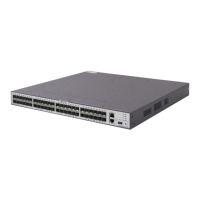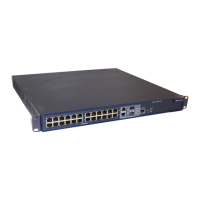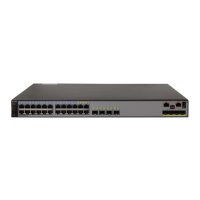If a switch does not support or is not installed with a rear card, the Ethernet cables used on its
electrical ports and the distance between the switch front panel and cabinet front door must
meet the requirements described in Table 7-1.
Table 7-1 Requirements for Ethernet cables
Network
Cable
Type
Distance (Excluding the Length of a Copper Module) Between the
Switch Front Panel and Cabinet Front Door (X)
Category 5
unshielded
twisted pair X ≥ 80 mm (3.1 in.)
Category 5
shielded
twisted pair X ≥ 110 mm (4.3 in.)
Category 6
twisted pair
X ≥ 120 mm (4.7 in.)
NOTE
l For a switch with 48 electrical ports, route Ethernet cables from both sides of the cabinet.
Specifically, route cables to the first 24 ports from the left of the cabinet, and to the last 24 ports
from the right of the cabinet.
l If the cabinet is densely cabled from both sides, it is recommended to reserve 1 U of clearance below
the switch for a cable tray. Route the Ethernet cables through the cable tray and bundle the cables on
both sides of the cabinet, to ensure that the weight of the cables is supported by the cabinet.
When a switch is installed with a rear card:
l In a cabinet deeper than 600 mm, the Ethernet cables used on its electrical ports and the
distance between the switch front panel and cabinet front door must meet the
requirements described in Table 7-1. There is no specific requirement for the distance
between the switch rear panel and cabinet rear door.
l In a 600 mm deep cabinet, the Ethernet cables used on its electrical ports, the optical
fibers used on the rear card, and the distances between the switch panels and cabinet
doors must meet the requirements described in Table 7-2.
S2700&S3700&S5700&S6700 Switch
Hardware Installation and Maintenance Guide
7 Connecting a Switch
Issue 13 (2017-11-20) Huawei Proprietary and Confidential
Copyright © Huawei Technologies Co., Ltd.
57

